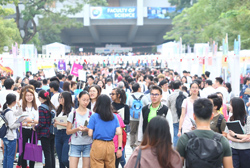
Welcome address to new students
.jpg)
Like the delicate flutter of a butterfly's wings, the interconnectedness of our globalised world sets in motion a chain of events that reverberates across continents and shapes the destiny of nations. In this intricate dance of interdependence, universities emerge as the transformative catalysts, nurturing the talent and knowledge that transcend borders. They hold the power to harness the butterfly effect, weaving a tapestry of innovation and collaboration that transcends boundaries, propelling humanity forward in the winds of progress.
But what is it about universities which make them so enduring as institutions when so many other features of our societies are prone to the tides of history?
Universities are often seen as the perfect platforms for countries or regions to showcase their unique capacities and potentials to the world. It is thus noteworthy that increased participation rates in higher education, investments in innovative research, and the emergence of high-quality universities have demonstrated a remarkable shift in the global centre of gravity towards Asia.
However, the world has experienced relentless waves of recent change, affecting universities in Asia, and potentially worldwide, in significant ways.
One of the notable challenges is an ageing population. Demographic trends have profound implications on universities as education is fundamentally a people's business. The United Nations Population Fund projects that by 2050, the number of elderly individuals over 60 years old in the Asia-Pacific region will triple, reaching approximately 1.3 billion people, accounting for 25% of the total population. A number of Asian countries, in particular Japan, South Korea, and China, are grappling with declining birth rates. These trends not only lead to a diminishing working population but also pose challenges to universities in terms of their size, shape, research intensity, and funding available for research.
In addition to ageing populations, Asian higher education faces the complexities of growing geopolitical tensions. Sino-US tensions, for instance, have deterred students from enrolling in overseas higher education programmes in both countries. Geopolitical dynamics have also created barriers to transnational collaborations, hindering the exchange of knowledge and expertise necessary for generating new discoveries, innovations, and achieving progress in some of our planet’s most pressing challenges.
Against this environment, Asian universities must embrace imaginative thinking to devise viable solutions. They are more motivated than ever to revamp their staff and student recruitment strategies to address challenges posed by ageing populations. Some institutions are actively promoting lifelong learning programmes for returning and mature students to counter the shrinking young adult population. Others are diversifying their student base by targeting international students through partnerships with overseas universities, easing visa restrictions, or recognising alternative international qualifications to gain entry to their institutions.
Another avenue for Asian universities is closely aligning university education with national strategies.
In China, establishing a strong connection between university education and national strategy has played a pivotal role in maintaining a competitive sector. The nation’s higher education sector has changed dramatically, positioning its universities as highly attractive destinations for both domestic and international students.
China has achieved the remarkable status of being the world's largest producer of scientific outputs, signifying its increasing prominence in research and innovation. This accomplishment has propelled Chinese universities to higher ranks on global league tables, bolstering their appeal among students seeking a high-quality education, and increasing China’s prestige as a global research destination.
Despite the challenges posed by a shrinking school-age population and a projected 38% decline in the number of school leavers by 2050, China's overall population size helps offset these issues. In addition, the Chinese government has focused on quality and driving institutional performance. This focus on excellence, coupled with ambitious targets to attract international students, demonstrates a strong commitment to nurturing a world-class higher education system.
Flexible strategies such as these have mitigated the decline in university student numbers in Asian economies, despite the ageing population. Some countries have even celebrated unprecedented records. For example, despite recent reports of closures and mergers across the sector, South Korea has experienced an increase in international student enrolment, reaching its target of hosting 200,000 students this year, a notable leap from just 12,314 two decades ago.
Nevertheless, addressing megatrends such as demographics, geopolitical tensions, and the rise of technology requires collective efforts and big-picture thinking. Asian universities must collaborate to navigate shared challenges. At the recent Times Higher Education Asia Universities Summit co-hosted by The Chinese University of Hong Kong, more than 500 higher education leaders from over 140 leading universities and organisations across Asia and beyond gathered in Hong Kong to discuss the “Asian University in 2050”. The Summit witnessed an energetic and enthusiastic display of a spirit of cooperation and partnership, serving as a powerful reminder of the importance of collaborations to drive the sector’s development over the coming decades.

History has demonstrated that universities, as the epicenters of knowledge, possess the ability to adapt to change and spearhead positive global transformations. Asian universities, situated at the centre of growing power and impact, should leverage our unique geographical location to navigate the complexity of the 21st century.
By cementing partnerships and learning from best practice, we can collectively address the skills gap, equip the younger generation for the future workplace, combat misinformation in the digital era, respond to climate change, and tackle other grand challenges of our time. Moreover, universities are uniquely positioned to ride the digital wave of the 4th Industrial Revolution and harness the power of artificial intelligence for the good of mankind. The value of universities is so much more than their individual missions or the value of what they bring to their local communities – the true power of higher education lies in the collective value of what we can do together.